
Skinks are lizards belonging to the family Scincidae, a family in the infraorder Scincomorpha. With more than 1,500 described species across 100 different taxonomic genera, the family Scincidae is one of the most diverse families of lizards. Skinks are characterized by their smaller legs in comparison to typical lizards and are found in different habitats except arctic and subarctic regions.

Cryptoblepharus is a genus of skinks, lizards in the family Scincidae. The genus contains at least 53 species.
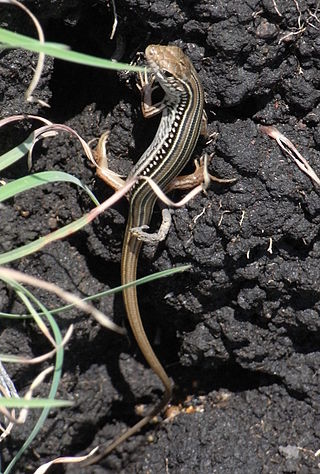
Ctenotus is a genus of skinks. It is endemic to Australia. The genus belongs to a clade in the Sphenomorphus group which contains such genera as Anomalopus and the close relatives Eulamprus and Gnypetoscincus.

The genus Eumeces comprises four African to Middle-Eastern skink species.
Euprepis is an obsolete genus of skinks in the subfamily Lygosominae. It was named by Wagler in 1830 and frequently used in subsequent years, often misspelled as Euprepes, a misspelling introduced by Wiegmann in 1834. It was then subsumed under the large skink genus Mabuya, until Mausfeld and others resurrected it for a group of mainly African skinks they split from Mabuya. The following year, Bauer argued that this assignment had been in error and that this group should be called Trachylepis instead. Euprepis itself is a junior synonym of Mabuya.

Lygosoma is a genus of lizards, commonly known as supple skinks or writhing skinks, which are members of the family Scincidae. Lygosoma is the type genus of the subfamily Lygosominae. The common name, writhing skinks, refers to the way these stubby-legged animals move, snake-like but more slowly and more awkwardly.

Barkudia insularis, commonly known as the Madras spotted skink, is a critically endangered limbless skink which was described in 1917 by Nelson Annandale and rediscovered in the wild in 2003. Little is known about the species but it was previously believed to be found only in the mangrove habitats near Barkuda Island in Chilka Lake, Odisha, India. Later observations in adjoining parts of Odisha indicate a larger range within the state. The lizard looks like a large earthworm and lives in the subsoil and probably feeds on small arthropods.

The broad-headed skink or broadhead skink is species of lizard, endemic to the southeastern United States. The broadhead skink occurs in sympatry with the five-lined skink and Southeastern five-lined skink in forest of the Southeastern United States. All three species are phenotypically similar throughout much of their development and were considered a single species prior to the mid-1930s.

The Eastern Ghats are a discontinuous range of mountains along India's eastern coast. The Eastern Ghats pass through the states of Odisha and Andhra Pradesh to Tamil Nadu by, passing parts of Karnataka and Telangana on the way. They are eroded and cut through by four major rivers of peninsular India, the Mahanadi, Godavari, Krishna and Kaveri. Sitamma Konda is the highest point in both Andhra Pradesh and the Eastern Ghats at 1,680 metres (5,510 ft). The Biligiriranga Hills in Karnataka are the tallest hill range in the Eastern Ghats, with many peaks above 1500 m in height.
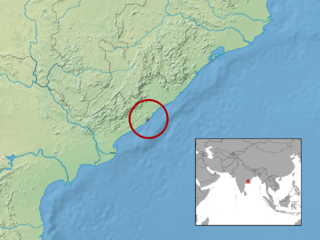
Barkudia melanosticta commonly known as Visakhapatnam limbless skink or Russell's legless skink is a skink endemic to Vishakapatnam region of Circar Coast, in Andhra Pradesh state of southeastern India. One of the foremost of Indian reptiles collected during the days of Patrick Russell in 1790s, this species' type specimen was considered lost. Later its taxonomy was fixed by redescribing recent collections dating between 1950s-80s by professors of Andhra University, Waltair from their campus, and deposited in the Zoological Survey of India in Kolkata, India.

Eumeces schneiderii, commonly known as Schneider's skink, is a species of lizard in the family Scincidae. The species is endemic to Central Asia, Western Asia, and North Africa. There are five recognized subspecies.
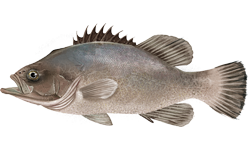
The wreckfish are a family, Polyprionidae in the suborder Percoidei of the order Perciformes.

Somniosus is a widely distributed genus of deepwater dogfish sharks in the family Somniosidae. Several members of the genus are believed to attain lengths up to 7 m (23 ft), thus ranking among the largest of sharks.
Macrognathus is a genus of eel-like fish of the family Mastacembelidae of the order Synbranchiformes.
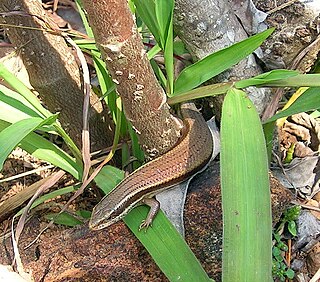
Lygosominae is the largest subfamily of skinks in the family Scincidae. The subfamily can be divided into a number of genus groups. If the rarely used taxonomic rank of infrafamily is employed, the genus groups would be designated as such, but such a move would require a formal description according to the ICZN standards.

The cleftbelly trevally, also known as the cleftbelly kingfish, Kuweh trevally or thin crevalle, is a species of tropical marine fish of the jack family, Carangidae. The species inhabits coastal waters throughout the Indo-West Pacific region from South Africa in the west to Japan in the east, often found near the water's surface. The cleftbelly trevally is the only member of the genus Atropus and is distinguished by a number of anatomical characteristics, with a deep median groove in the belly giving the species its common name. It is not a large fish, growing to a maximum recorded length of 26.5 cm. Cleftbelly trevally are predatory fish, taking a variety of small crustaceans and fish. The species is of minor importance to fisheries throughout its range.
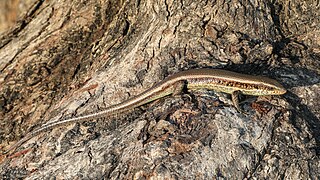
Eutropis is a genus of skinks belonging to the subfamily Mabuyinae. For long, this genus was included in the "wastebin taxon" Mabuya; it contains the Asian mabuyas. They often share their habitat with the related common skinks (Sphenomorphus), but they do not compete significantly as their ecological niches differ. This genus also contains the only member of the subfamily to occur in Australasia, the many-lined sun skink, whose wide range includes New Guinea.

The Indonesian blue-tongued skink is a lizard in the family Scincidae. It is a close relative of the eastern blue-tongued lizard. They are endemic to the island of New Guinea and other various surrounding islands. They are found typically in the rainforest, and in captivity, require high humidity. In comparison to Tiliqua scincoides, they are fairly lean. They also have long tails.

Spondylurus is a genus of lizards in the family Scincidae. The genus Spondylurus, vernacularly known as the Antillean four-lined skinks, is a neotropical skink taxon including many species.















